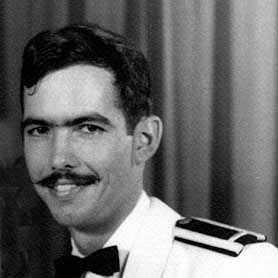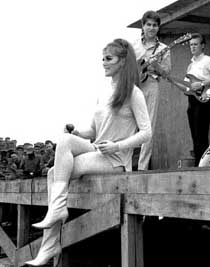A TIME FOR REFLECTION Someone recently sent me some "old photographs" of B-52 bombers and other bomber aircraft. When I came to the photo above, I recognized it immediately and felt old. I felt old because I was there on Guam the day that the photo was taken. I recognized several of the guys in the photograph, since we were all from Columbus AFB, but I have forgotten their names, except for Bob Amos (third from left), who I didn't know well. It helped to see his name on the photo. The copilot, who is to the right of Jimmy Stewart, is Lee Meyers. Fortunately, I wasn't as old as Jimmy Stewart, who is the one in the center. He was born in 1908; a year after my father was born. This photo, with Jimmy Stewart, is of a B-52 crew who had just returned from (or was just about to depart on) a bombing mission from Guam to Vietnam and back. It was early in 1966 and still winter. But then winter on Guam is like summer on a tropical island, which it is. I was also flying that day on the same mission, but in a different B-52. Jimmy Stewart flew on this mission as an observer. He was a brigadier general in the AF reserves at the time, and was visiting Guam. He was only there for a few days, and only flew one mission. I was on my second temporary duty tour from Columbus AFT, Mississippi. We had flown to Guam from Columbus, Mississippi in November of 1965. That was the year I had no Thanksgiving. We departed the day before Thanksgiving, but crossed the International Date Line exactly at midnight, so suddenly it was the day after Thanksgiving. I had my Honda Dream 350 CC motorcycle strapped in the bomb bay, so I was ready to explore Guam and have new experiences. Little did I know then what great experiences they would be. There were quite a few aircraft on each mission. The aircraft in the photo had logged at least 35 missions over Nam as represented by the bombs painted on the fuselage. Our missions took off from Guam and refueled over the Philippines by KC-135 tankers out of Okinawa and then on to Vietnam to our targets. It was a long, boring flight back to Guam–at least 11-12 hours round trip. I first met Jimmy Stewart at the end of this mission when all the crew members were at Gilligan's Island (an after-mission, outside gathering for drinks and war stories). I got to talk with him again at a debutante's ball that Saturday night at the officer's club. I was the escort for the vice-wing commander's daughter, who was probably only 18. I do recall the vice-wing commander's wife causing a commotion the week prior when she thought I was not a "Caucasian" male because of my very dark tan. (Yes, there was a lot more racial prejudice back in 1966.)
I was posting mission status on the mission board when the colonel came over to introduce Jimmy Stewart to me. Jimmy said, "Oh, I know Lew. Mighty fine mustache, eh colonel?" The commander was shocked. I guess he thought Jimmy Stewart and I were buddies. Anyway, the colonel never again mentioned my mustache, even after I returned to Columbus AFB, Mississippi and kept it for at least a year. Around
the same time period that Jimmy Stewart visited, we also got a visit
from Anne Margaret, who was returning from her February 1966 show tour
in Vietnam. I sort of made up for it when we went to Okinawa on a short R&R, and I advanced international relations via a three-day liaison with a young Japanese woman, Ruriko Kishimoto. She ended up writing my mother in her quest to immigrate to the U.S., so perhaps we both were taking advantage of one another. I happened upon her again (no pun intended) in 1968 when I returned to Okinawa flying C-141's. I'm sure she is a grandmother by now. My first temporary duty tour on Guam had been the previous summer in 1965. I had the honor of flying on the first combat mission for B-52's over Vietnam. In fact I believe it was the first combat mission ever for a B-52. It was code named Arc Light. Back in the states, we had been training for dropping "iron bombs" for some time before our deployment to Guam, and our B-52's had been reconfigured to carry them instead of the nukes. B-52s had been in service since 1955, but never used in actual combat. Prior to this combat mission I had only flown airborne alert missions carrying nuclear bombs. We flew from Mississippi all the way to the end of the Mediterranean Sea and back; a 24-hour mission where we refueled off the coast of Spain coming and going. (There is some irony in that, years later, I ended up dating a Russian woman, Svetlana, who grew up in a city that was one of our assigned nuclear targets.) It was June 18th, 1965, when we took off from Guam in a strike force of 30 bombers on the first bombing raid over Vietnam. Our target was a communist stronghold near Ben Cat, north of Saigon in South Vietnam. The AF had never flown this many B-52's on one mission, and probably not this many bombers since WWII, so there was a lot of confusion. I remember the pre-mission briefing, and the commander saying to all of us, "We don't know what the hell we are doing, but whatever you do, do it professionally." The first wave of bombers arrived early at the designated rendezvous point to refuel with the tankers. Our rendezvous point was north of the Philippine Islands and about three hours from Guam. Normally, refueling took about 15 minutes and we took on an additional 80,000 lbs of jet fuel, which gave us enough to get to the target and home again. Arriving at the rendezvous point ahead of schedule, we had to do an unplanned orbit to wait for the tankers, and two B-52s collided, resulting in the loss of two B-52 bombers and eight crewmen. I had a couple of good friends on one of the aircraft that went down. One more bomber returned to Guam due to mechanical problems that prevented it from refueling, but the remaining 27 bombers went on to the target. We never flew that many bombers again on a single mission. We use to be called "The Monkey Killers" because dropping bombs from 30,000 feet kept you from really seeing what it was that you were bombing other than jungle. Then, while in Okinawa, I happened to come across some army infantry guys in a bar who were on R&R from Vietnam. When they found out I was on a B-52 crew, they practically cried with appreciation, saying how we had saved their lives. The short version is that they were virtually cut off from help and about to be overrun when a B-52 strike literally wiped out the enemy. Needless to say, I wasn't allowed to spend a dime that evening. The B-52s continued to be used over Vietnam for the next eight years, flying a total of 126,615 sorties. Twenty-nine more B-52s, and a lot of good crew members, were lost. I salute those men, as well as Jimmy Stewart, Ann Margaret, Bob Hope and his show, and all of the others who were part of my Guam experience. |

 I
spoke with Stewart a third time on Sunday at the command post. Jimmy
even remembered my name. I was very impressed. I had a handlebar mustache
at the time, which was not in compliance with the regulations, but my
wing commander (Col. Kaminski) had not ordered me to shave it. However,
he had said, "Hofmann, when are you going to shave that God-dammed
Egyptian mustache?" For most junior officers, that would have
been sufficient.
I
spoke with Stewart a third time on Sunday at the command post. Jimmy
even remembered my name. I was very impressed. I had a handlebar mustache
at the time, which was not in compliance with the regulations, but my
wing commander (Col. Kaminski) had not ordered me to shave it. However,
he had said, "Hofmann, when are you going to shave that God-dammed
Egyptian mustache?" For most junior officers, that would have
been sufficient.
